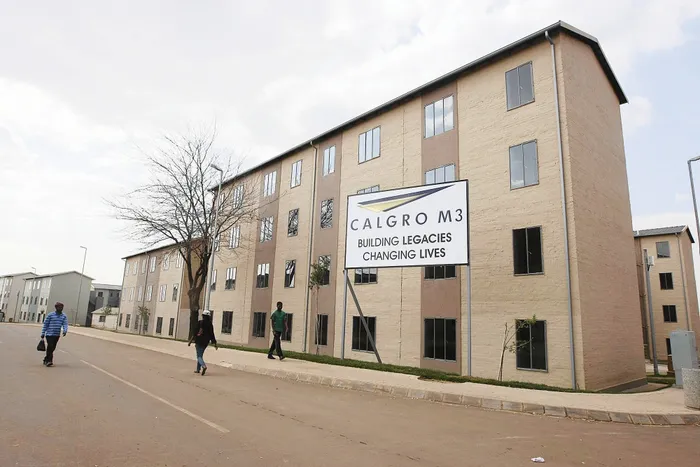Calgro M3 addresses South Africa's housing shortage through robust development pipeline
Housing

Calgro M3 has nine integrated housing developments contributing to revenue and profitability in Gauteng and the Western Cape currently underway, while it is putting down the infrastructure for the 20 000 unit Bankenveld project, near Sandton.
Image: Leon Nicholas/African News Agency (ANA)
Calgro M3’s robust development pipeline is helping to address South Africa’s serious housing shortage, but more needs to be done to lower the barriers to entry in the affordable housing sector, said the group CEO Ben Pierre Malherbe.
He was interviewed at the release on Monday of the integrated development and memorial park group's annual results for the year to February 28, which showed it had maintained profit margin growth, continued to expand in both business segments, and all in spite of revenue pressures and a decision to temporarily slow production in the first half.
The group had 36 000 residential opportunities secured at the end of the financial year, he said. The pipeline includes the newly acquired Bankenveld District City Development near Sandton, which will add in excess of 20 000 units to the group’s pipeline.
Malherbe said that for companies wishing to enter the low-cost housing market, it was a long development cycle compared with other countries, in that in South Africa, developers first have to establish bulk services and infrastructure, before building, a process that could add up to two years to the development time and costs. In many other countries, these costs are borne by the government in one way or another.
Calgro M3, in partnership with joint venture partner Eris Property Group, exercised the option to acquire the Bankenveld land in September 2024. The development presents an opportunity for the group, which is currently on site working on the infrastructure, he said.
Located near the Sandton and Waterfall City hubs and bordering Alexandra and the Marlboro Gautrain station, the project represents the last large-scale undeveloped property in the Sandton area and is well suited to meet the needs of most South Africans to be located more closely to their places of employment, said Malherbe.
The first phase of infrastructure installation started in the first quarter of 2025.
The results showed revenue and profit fell by 32.68% and 15.19%, respectively. This was from a decision to slow production in the first half due to political uncertainty around the elections, as well as to unlock existing stock value by leveraging prior investments in land and infrastructure costs.
But gross profit margins increased to 29.43% from 27.21%, exceeding the target range of 20% to 25%. Cash increased by 26.16% to R154.7 million from R122.6m. Net debt to equity level was stable at 0.65 from 0.63 last year. Headline earnings per share decreased to 171.36 cents from 188.95 cents.
The final dividend was lowered to 8.64 cents per share from 9.49 cents. Revenue had decreased to R868.9m from R1.29 billion.
“Our year was marked by resilience…we are pleased with the results when one thinks about the uncertain environment we traded in last year,” he said.
Although interest rates began trending downward in the latter half of 2024, the full impact on home loan affordability was only expected to materialise by the third quarter of 2025 – about nine months after the rate cut cycle commenced.
He said the gross profit margin benefited from historic land and infrastructure costs that optimised margin growth, a focus on open market sales, and stringent cost control. For the year, group revenue and profit fell by 32.68% and 15.19%, respectively.
The residential property development segment, the most significant contributor to group performance, has nine active projects in Gauteng and Western Cape, all contributing to revenue and profit, with the products ranging from fully subsidised to premium homes above R3m.
“This diversity allows us to navigate current economic and market conditions effectively. Our focus is on delivering value-for-money homes in integrated developments and lifestyle estates, reaching a wide spectrum of different market segments with a keen focus on those in dire need of housing,” Malherbe said.
The focus on delivery mix and the shift to greater open market sales had significantly contributed to growth in the group’s gross profit.
Amid challenging economic conditions and the large volume of stock on hand, the group prioritised the completion of infrastructure installations across its existing development pipeline. Significant progress was made in completing bulk infrastructure requirements in the Fleurhof development.
Malherbe said he anticipated gross profit margin growth might fall to within the targeted range in the new financial year.
The Memorial Parks segment delivered another year of growth with its revenue contribution to the group increasing to 8%, up from 4% in the previous year, reflecting significant growth and expansion. Cash receipts grew by 41.3% in the year.
“This business segment met its target of covering group overhead costs. This upward trend reflects success in our improved sales strategies, increased market penetration, and enhanced customer confidence,” said Malherbe.